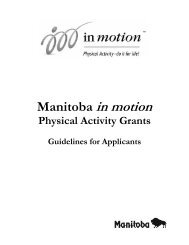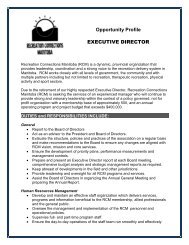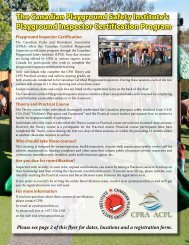Suggested Guideline for Evaluating Arena Boards and Glass
Suggested Guideline for Evaluating Arena Boards and Glass
Suggested Guideline for Evaluating Arena Boards and Glass
You also want an ePaper? Increase the reach of your titles
YUMPU automatically turns print PDFs into web optimized ePapers that Google loves.
<strong>Suggested</strong> <strong>Guideline</strong>s <strong>for</strong> <strong>Evaluating</strong><strong>Arena</strong> <strong>Boards</strong> <strong>and</strong> <strong>Glass</strong>INTRODUCTIONDue to the changes in sport activities accommodated in facilities specificallyarenas, safety of players <strong>and</strong> spectators has become an issue. This is due, in part,to the age of many arenas, combined with various <strong>and</strong> non-st<strong>and</strong>ard buildingpractices used during the construction of the facilities.Consequently, the industry is experiencing an increase in the number of injuries,some fatal, sustained by spectators <strong>and</strong> players alike. This has resulted in anincreased concern <strong>for</strong> potential litigation.In Canada, several ongoing claims <strong>for</strong> injuries has brought this issue to the<strong>for</strong>efront. At the 1999 Annual meeting of the Canadian Recreation FacilitiesCouncil, (CRFC) the need to develop specific guidelines to determine the safestheight <strong>for</strong> glass <strong>for</strong> arena facilities was identified.C.R.F.C. is a network of Provincial <strong>and</strong> Territorial recreation facility associationsfrom across Canada. This volunteer organization is working collectively toimprove the recreation facility industry.In response to the need <strong>for</strong> owners <strong>and</strong> operators to demonstrate a duty of careto users of their facilities, the Ontario Recreation Facilities Associationrecommends the following guidelines <strong>and</strong> facility analysis to help reduceunnecessary risks <strong>and</strong> assist in maximizing the safety of our patrons.The main objective of this process is to ensure that the arena facility has taken allreasonable steps to minimize risk to user groups <strong>and</strong> spectators.Please read through the following guidelines in evaluating your facility <strong>and</strong> set upyour own committee or task <strong>for</strong>ce to implement the recommendations attached.Designate one person to implement these guidelines in your facility.<strong>Suggested</strong> <strong>Guideline</strong>s <strong>for</strong> <strong>Evaluating</strong> <strong>Arena</strong> <strong>Boards</strong> <strong>and</strong> <strong>Glass</strong>- 4 -
EVALUATING YOUR PREMISESAre the persons who are responsible <strong>for</strong> the maintenance of the board <strong>and</strong> glasssystem aware of the following:• the age <strong>and</strong> type of construction of your facility’s board <strong>and</strong> glass system?• the exact height of glass as measured from the ice surface to the top of theglass?• The exact height of glass measured from the concrete floor on the spectator(off ice) side to the top of the glass?• the type <strong>and</strong> dimensions of the spectator seating?• is the board <strong>and</strong> glass system removable or permanent?• can the existing board system support an increase to glass height?• does the seating cause any risk to the spectator at any point?• are all of the exposed supports padded?Are you aware of the facility requirements necessary <strong>for</strong> the type of programs thatyou are scheduling?Do you have access to in<strong>for</strong>mation about programs offered at your facility orspecific playing guidelines <strong>for</strong> that activity?Do you actively review accident/incident <strong>for</strong>ms involving participant <strong>and</strong> orspectator injuries? Is this done to the extent that a summary of incidents/accidentsreceived in your facility reveal recommendations <strong>and</strong> or changes to be made ineither the programming or the structure.Is there a design problem noticed through consistent spectator or player injury<strong>and</strong> what action is to be taken.Site VisitSelf-assessment is an important step in effectively evaluating your facility. Aplanned walk through of your playing surface is m<strong>and</strong>atory in the assessmentprocess. For your self-assessment you will require a measuring tape <strong>and</strong> equipmentsuch as a hockey or lacrosse stick. It is recommended that you invite keypersonnel such as the Fire Department, Building Department, Joint Health <strong>and</strong>Safety Committee <strong>and</strong> or insurance advisors, to join this step of the process. All<strong>Suggested</strong> <strong>Guideline</strong>s <strong>for</strong> <strong>Evaluating</strong> <strong>Arena</strong> <strong>Boards</strong> <strong>and</strong> <strong>Glass</strong>- 5 -
ObservationsThe following are guidelines to assist you in summarizing the state of your arena<strong>and</strong> identifying potential risks. This in<strong>for</strong>mation will help you to establish yourAction Plan. Review the following possible conclusions drawn from the datagathered.General Evaluation• Note any consistencies in player or spectator injury observed by staff oruser groups.• Are there any programming issues that may pose a hazard to public safety.• Should there be any policies or procedures implemented to protect usergroups <strong>and</strong> spectators. (e.g. ensuring that all gates are closed during practicesessions.)<strong>Boards</strong>/<strong>Glass</strong> Evaluation• In the data sheets, highlight the existing problems by marking an “X” onyour drawing.• Check the outside measurement of the dasher system. Compare to theinside <strong>and</strong> measure the shield height.• Is the height of the dashers on the spectator’s side of your arena shorterthan the ice side? If yes, are patrons at risk when st<strong>and</strong>ing or sitting aroundthe rink?• Are the patrons of your rink protected from the risk of a flying puck or stickwhile st<strong>and</strong>ing or sitting in any part of your arena?• Are there any gaps where pucks or other objects can go through?• Can a flying puck or ball get into an adjacent traffic area?• Are there any gaps or weak spots in the boards that will cause a player tobecome injured or allow <strong>for</strong> a stick to get caught?Action PlanFrom the above summary, list your specific problem areas that need to beaddressed. For every problem, identify <strong>and</strong> list possible solutions that may ormay not be feasible including any associated costs <strong>and</strong> ease of implementation.Example:Problem: gap in glassSolution: 1. Replace <strong>and</strong> fix shield supports2. Stop playing activity3. Replace glass<strong>Suggested</strong> <strong>Guideline</strong>s <strong>for</strong> <strong>Evaluating</strong> <strong>Arena</strong> <strong>Boards</strong> <strong>and</strong> <strong>Glass</strong>- 7 -
11. Measure:• measure height of dashers from top of topsill to ice (1A1A) <strong>and</strong> top of topsillto the base of the dasher (1B1B)• measure total height of dasher system from top of shields to ice (2A2A) <strong>and</strong>from top of shields to surface behind the dashers (2B2B).• measure top of shields to topsill <strong>for</strong> shield height at both the sides <strong>and</strong> theends.Ice Side2ASpectator Side2B1A1BICE<strong>Suggested</strong> <strong>Guideline</strong>s <strong>for</strong> <strong>Evaluating</strong> <strong>Arena</strong> <strong>Boards</strong> <strong>and</strong> <strong>Glass</strong>- 10 -







